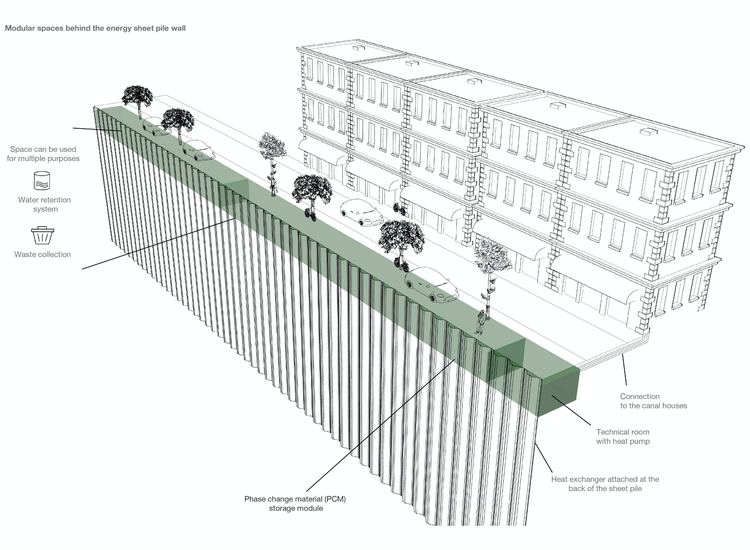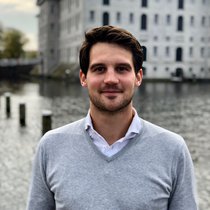During the ten-day music event at numerous locations throughout the historic center, Amsterdam's canals serve as a festival setting where past, present, and future come together in contemporary combinations of musicians, genres and locations. This year’s edition of course with extra COVID19 measures in place.
Historically and in present time the canal system is a vital element of the Amsterdam city infrastructure. It is part of the city’s DNA and is a dominant factor in the unique atmosphere of the inner city, which is cherished by the city, its inhabitants and visitors. Because the canals shape Amsterdam and the foundations the city is built on, it takes in an important place in creating solutions to make Amsterdam future proof – from developing innovative smart urban mobility to urban energy solutions.
With these projects the Amsterdam canals are at center stage for our research on urban innovation:
1) Innovative autonomous boats in our historic canals
With 165 canals winding alongside busy city streets, about a quarter of Amsterdam’s surface area is water. Whereas autonomous shipping focuses on more straightforward trajectories, we wondered: what if autonomous boats could relieve Amsterdam's city center of heavy traffic over its vulnerable quays and bridges while making the canals a testbed for innovation?
Roboat – a research project by MIT Senseable City Lab and AMS Institute – is the world’s first major research program on autonomous floating vessels in metropolitan areas. After working on 1:4 and 1:2 scale prototypes in the first years of research, we launched the full-scale prototype last year. Roboat has a unique modular design that allows the vessels to be applied for multiple use cases: transportation of people and garbage collection, as well as stages and bridges when latched together.
The five-year research project is now in its final phase of research & development. Last April, Deputy Mayor Everhardt officially put the new slewing crane at Marineterrein Amsterdam into operation. With the crane the full-scale Roboat can easily be launched in the water.
This milestone launched the tests of the full-scale prototype of Roboat at Marineterrein Amsterdam Living Lab (MALL). And as of now visitors of Marineterrein Amsterdam will be able to see Roboat in action in the inner harbour of the area.
“How to deal with scarce space is an issue for many cities, and this certainly also applies to Amsterdam. A big part of the city consists of water surface, so it makes sense to make use of this. It is therefore great that at Marineterrein experiments with innovations such as Roboat take place and that here it is investigated whether autonomous transport is possible on the canals.”
Deputy Mayor Victor Everhardt | City of Amsterdam

2) World’s first 3D printed smart bridge as a 'Living Lab' to understand cityness
Last month, with a festive opening by Her Majesty Queen Máxima, Dutch technology scale up MX3D unveiled the world’s first 3D printed smart bridge located at one of the oldest canals at the Oudezijds Achterburgwal. The bridge is equipped with sensory technology, empowering citizens to interact with the bridge. In turn, the smart bridge enables the “BRIdging Data in the built Environment” research team to better understand Amsterdam’s cityness.
The bridge's sophisticated sensor network enables the researchers to collected real-time data, to represent those data flows in live models, and to create usable analytics on top of that data which feeds into a Digital Twin of the bridge.
The bridge’s sensors collect structural measurements such as strain, rotation, load, displacement, and vibration, and also measure environmental factors such as air quality and temperature. Together, this data is used to create a ‘digital twin,’ an accurate computer model that represents the physical bridge in real time. The digital twin will help engineers measure the bridge’s health and monitor how it changes over its lifespan. The sensor data will also be used to “teach” the bridge to understand what is happening on it, beginning with the ability to count how many people are crossing it and how quickly.
With the “BRIDE project, we dive into the ethical consequences and regulation of smart infrastructures in the city. Questions such as: 'what do we as citizens actually want measured' and 'to whom does the collected data belong' and 'do we actually want a city full of sensors', are central to this. As such, the bridge will become a true 'Living Lab'.
“Cities are meant for humans. It is important to find out how citizens and visitors (prefer to) interact with smart objects in public space. Together with researchers from TU Delft we will look into how people respond to the MX3D bridge.”
3) Technical innovations to our renovate our historic quays
The City of Amsterdam is responsible for the management and maintenance of a great number of bridges and quays. The fact of the matter is: for about 200 km of quay walls and 850 bridges there is not enough information available as of yet on what state they are in and what load they can still handle.
The canal borders Amsterdam are vertical masonry walls with timber pile foundations. To illustrate, there are no sufficient historic records available of the composition of the soil around these walls; an important factor that determines the state of the quays. And due to their age – these quays can be up to 300 years old – and changed conditions, many quay walls are to be considered as sub-standard, and potentially unsafe.
For example, these recent incidents show the importance of taking immediate action on the topic. Together with TU Delft, we assist the City in developing technical solutions to better our understanding of the structural and shallow subsurface conditions affecting the behavior of historical quay walls.
The project consists of two interrelated parts: the first part concerns the structural modeling of a the quay wall using a fast analytical model representative of the ‘true’ behavior of a quay wall. The second part is concerned with the application of existing and new geophysical and geotechnical techniques for near-surface soil characterization. Together, the two parts constitute a perfect assessment tool to have a reliable indication of the structural condition and safety of historical quay walls in Amsterdam and to prioritize those that require renovation and replacement.
4) Sustainable heating solutions for the city's historic buildings
Amsterdam formulated a number of ambitions to become energy neutral by 2050. For example, to reduce CO2 emissions by 95% by the year 2050, to eliminate the use of natural gas by 2040, phase out fossil fuels by 2050, and have 80% of the electricity that households use to be generated by solar and wind energy in 2030.
To meet these energy ambitions, it is crucial to define a long-term strategy for the inner city – this historic area has the highest heat demand density in Amsterdam. Recently, the City developed scenarios to replace natural gas as the primary source for heating in the different neighborhoods of Amsterdam. For the inner city, Amsterdam focuses on a 70% gas reduction in 2040 and to use biogas and hydrogen in combination with hybrid solutions for the remaining.
“Since historic buildings constitute a considerable share of the city centers’ building stock, the challenge is to develop energy retrofit approaches and solutions that preserve Amsterdam's historic buildings.”
Paul Voskuilen
Program Developer Urban Energy
So, what energy-saving measures allow for maximum impact, while conserving our built heritage? With the High Hanging Fruit project, our researchers explore what energy retrofitting solutions can be developed that have the biggest impact in terms of sustainable energy while at the same time preserving the city’s historic and aesthetic values.
By identifying key recommendations and collective measures, the idea is to propose a generic approach on energy retrofit decisions. More specifically, we want to focus exclusively on sustainable heating solutions that are available locally.
A promising concept the aforementioned High Hanging Fruit project investigates is the implementation of an innovative canal wall that includes a heat exchanger that can be connected to a heat pump system. The heat from the canal water would be collected in the summer, stored in the subsurface, to use it in the winter when Amsterdam is heating itself. Such sustainable heating technology has not yet been used in a historic city center.
Investigating the implementation potential of this new type of canal walls offers opportunities to tackle multiple urban challenges in Amsterdam at once: implementing urban energy solutions while restoring the city’s canals.
“Resources like biogas and hydrogen are limited, expensive, and dependent on regional production, conversion, and transport capacities. Aquathermal energy from surface water could be a feasible alternative to natural gas in Amsterdam, since this city counts a large number of canals and open water.”
Maéva Dang
Research Fellow

An innovative canal wall that includes a heat exchanger
In addition to these research topics, our research portfolio revolves around six urban challenges – smart urban mobility, urban energy, circularity in urban regions, metropolitan food systems, climate resilient cities, and responsible urban digitization.
We work on integrating these themes to create an innovative, sustainable and just city. Each challenge is addressed with collaborative research to develop a deep understanding of the city.

